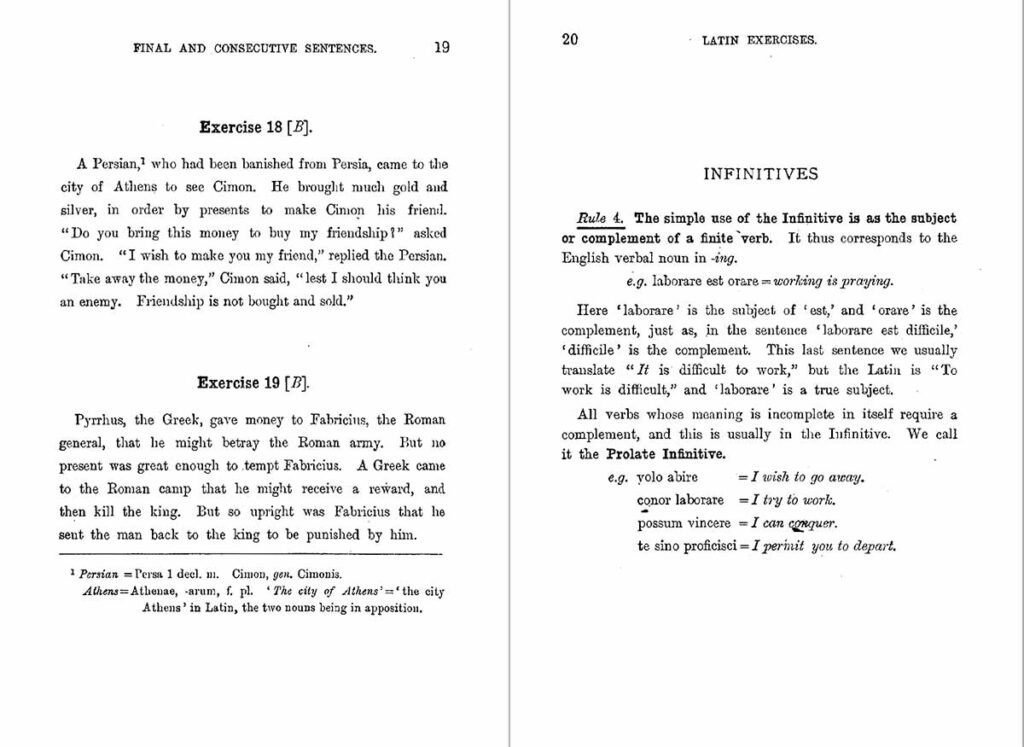Contents
- What is Latin prose composition?
- Is Latin prose composition useful?
- Which Latin prose composition book should I use?
- How are Latin prose composition books constructed?
- How to use a Latin prose composition book
- What not to do in Latin prose composition exercises
- Final tips for Latin prose composition
Have you ever come across something called “Latin prose composition” and wondered what it was, if it was useful, how to do it and where to begin?
Latin prose composition happens to be one of my favorite Latin learning and teaching techniques that I’ve used often myself and have my students use it.
Latin prose composition is not actual composition but an exercise in translating from a modern language into Latin. It is a didactic exercise with the focus of drilling vocabulary and grammar. Latin prose composition books, such as North and Hillard, and Bradley’s Arnold, seek to consolidate the students’ knowledge of Latin syntax and lexicon while also preparing them to use Latin actively and drastically improve their reading comprehension.
In this article, I’ll go through a few questions regarding Latin prose composition that I’ve gotten throughout my years of teaching Latin. I’ll also recommend which prose composition books to use, how to use them and how not to use them.
What is Latin prose composition?
Latin prose composition perhaps sounds a bit odd. “Composition” immediately brings to mind music composition, which is free and creative. Latin composition, however, is everything but free and creative. “Composition” here is rather a euphemism for old-fashioned structured translation exercises to drill vocabulary and grammar where you translate from a modern language into Latin. But it is a tried and true—and from my experience as a Latin teacher—fantastic language learning technique.
Latin prose composition guides you to start using Latin actively, even if it does so in a traditional, quite square way. It also consolidates and improves your vocabulary and grammar. It is (normally) a standard part of University classes in Latin—one of the few remaining exercises at Universities where you actually use Latin actively.

Is Latin prose composition useful?
Latin prose composition has three main utilities:
- Drill grammar, vocabulary, and common idioms and expressions
- Force you out of your comfort zone
- Start using Latin actively, in a guided manner.
Firstly, the well-structured and repetitive nature of Latin Prose composition books allows you to acquire a deep and nuanced understanding of Latin grammar and lexicon. Note that the main goal of these books is usually to have the reader internalize the phraseology and syntax of Caesar and Cicero, thus preparing for their subsequent reading.
This means you will learn a lot from their specific use of vocabulary and idioms – there is a lot of troop movements, military camps, charging, and accusing people. This might not sound too interesting, but it is advantageous when you read Roman authors.
Secondly, if you have a good Latin composition book (see below) or attend a good Latin composition class, you will be forced to practice things you didn’t even know you could practice or needed to practice.
In this manner, Latin prose composition is distinct from free form writing, wher you express your thoughts, and run the risk of staying within your language comfort zone.
You will thus be forced to move beyond the grammar and language you already know; if you have to translate a particular sentence, you cannot avoid it or use circumlocutions. You have to find a way to express the book’s sentence in Latin. This way, you will get a thorough run-through of Latin syntax, extend your vocabulary knowledge, and learn many great expressions along the way.
Lastly, Latin prose composition is fundamental if you want to write or speak Latin well. The exercises practice your active use of Latin, meaning you need to find the words yourself in your own head, formulate a sentence and make it correct. Starting to write Latin in this way builds the confidence needed to progress and speak Latin.
Which Latin prose composition book should I use?
A good Latin prose composition book will feel and function a little bit like a checklist: you can tick off one thing after another. First, you might practice the accusative with the infinitive, then the ablative of comparison, next indirect questions, and so forth.
This gives a satisfying sense of “finishing” things, making it easy to track your own progress. Granted, having done a few exercises on a particular aspect does not mean that you have internalized it, but it is a great first step. Review and reading will get you there.
There are several good Latin prose composition books out there. However, I do have two favorites that are great to use, one after the other.
The first one is North & Hillard’s Latin Prose Composition, which is aimed at students who are starting to write Latin – but keep in mind that you still need to know basic Latin when you begin as it is not written for complete beginners.
Once you’ve finished North & Hillard, the second book I recommend is Bradley’s Arnold Latin Prose Composition. This is the standard book for advanced prose composition and a very good one at that.
Note, if you feel that the content of these books is boring, you are likely correct. It is quite boring, but the exercise as a whole is fun.

How are Latin prose composition books constructed?
Usually, Latin prose composition books are divided into chapters with different topics, each focusing on one aspect of grammar or syntax. Both my favorites, North & Hillard and Bradley’s Arnold, are constructed in this way.
Every chapter begins with an explanation of the focus of the chapter, followed by a few more or less illuminating example sentences in Latin. Lastly, you find the actual exercise: English (or another modern language) sentences to be translated into Latin.

How to use a Latin prose composition book
To use a Latin prose composition book is fairly straightforward: Read the explanations and examples found in each chapter thoroughly. Then reread them. Make sure you understand them, and if you don’t, consult a grammar or two on the subject.
Next, read the sentence to be translated carefully. Note that the English in these books might be a little bit dusty and old-fashioned, and the meanings of certain words may be different today due to semantic change over the last hundred years.
Next, translate into Latin.
Remember, almost every English sentence is written so that it has to be translated with the grammar or syntax that that specific chapter teaches. If you, for instance, are translating sentences from the chapter on the genitive of price, the chances are that the sentence will want you to use the genitive of price in your translation.
After you have finished a chapter, check the answer key (available online) and see what you did well and what you need to review. Remember, however, that there are usually many ways you could translate a particular sentence. Still, if you read the chapter examples and use the book’s glossary, you will most likely come close to the answer in the key.

What not to do in Latin prose composition exercises
First of all, if you don’t know a word or an expression when translating into Latin, don’t look it up in a dictionary as would otherwise be recommended. Dictionaries will give you too much information, and chances are you might find the entire sentence that you’re trying to translate as an example in the dictionary. Remember that the books are preparing you for Cicero and Caesar, which means at times they use English translations of their texts, so you might actually find the “right” answer in a dictionary. Instead, use the list of vocabulary that you will find in the back of your prose composition book. That list will give you everything you need, no more no less.
Don’t rush. Do every composition exercise carefully and diligently. Don’t use a computer, instead, write by hand. This gives your brain extra time to process what you are doing and research has shown that “the additional context provided by the complex task of writing results in better memory” (Smoker, Murphy, Rockwell, 2009, “Comparing memory for handwriting versus typing.” In Proceedings of the Human Factors and Ergonomics Society Annual Meeting).
Final tips for Latin prose composition
Practice Latin prose composition every day: a chapter a day for a year will do wonders for your Latin, even if it might not feel like it now. In addition, when you feel the exercises are becoming too easy, try doing the orally, reading the english and translating instantly into Latin.
When you read Latin and encounter a construction or grammatical aspect that you’ve practiced in your prose composition book, stop for a while. Let it soak in that you have actually written similar sentences, which means that you are on your way to writing a Latin in the same style that the Romans did 2000 years ago. Take pride in that!
Finally, remember that Latin prose composition is guided translation drills and are only a small part of what you need to learn to read Latin literature: the most important thing to do is to read as much as possible.
















